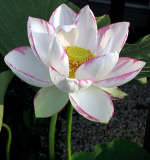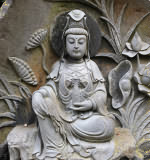| Töltsd le és telepítsd a nélkülözhetetlen betűtípusokat(s) Hogy megtekinthesd a Szanszkritot annak teljes fényében Olvass Transzliteráció (2) (magyar) hogy teljes mértékben átlásd a transzliterációs rendszert |
Tanulj Szanszkritul - Igék (2)
Igegyökök, nem változó alappal (1. Rész)-
| Gaṇa 1 | |
| Gaṇa 4 | |
| Gaṇa 6 | |
| Gaṇa 10 | |
| Gaṇa 1 | |
| Gaṇa 4 | |
| Gaṇa 6 | |
| Gaṇa 10 | |
Introduction: The first station
"Roots with unchangeable bases" is the first station in your climbing up the mountain called "Szanszkrit Verbs". This is the first document dealing with this subject. Although it was easy to get here, keep in mind that it is very important that you "fully" understand the basic premises about conjugation taught by me at this point. Follow my instructions to the letter and nothing will go wrong. The vast majority of Szanszkrit verbs belongs to 1st, 4th, 6th and 10th Houses or Classes. Thus, if you learn to conjugate them in a proper manner, it will be easier for you to make it to the summit.
Remember that the ten Houses or Classes only affect Present and Imperfect Tenses as well as Imperative and Potential Moods. Pay special attention to 10th House because the most part of the roots there are Derivative ones [See Verbs (1) (English)] for more information] despite there are some Primitive roots too. The process to conjugate a verb belonging to any of these four major Houses or Classes with unchangeable bases is a really easy-to-understand one. Here you are the well-known table to form Guṇa and Vṛddhi:
| Type | Vowels | ||||
|---|---|---|---|---|---|
| WEAKENED GRADATION (simple vowels) | a | i-ī | u-ū | ṛ-ṝ | ḷ |
| STRENGTHENED GRADATION (Guṇa) | a | e | o | ar | al |
| PROTRACTED GRADATION (Vṛddhi) | ā | ai | au | ār | āl |
As you know, the original root or "Dhātu" must be somehow "strengthened" and turned into a base or "Aṅga" before adding any ending to it. Guṇa, and sometimes Vṛddhi too, are good means to do that.
Ah!, two more things: 1) You will find here many examples of conjugation. 2) You will find a list of terminations here.
Let us get down to work!
GAṆA-S (Houses or Classes)
As I said, there are ten Houses or Classes (Gaṇa-s). Even though each of them states a particular way to conjugate the verbs belonging to it, it might be said that there are two major groups. The first group formed from 1st, 4th, 6th and 10th Houses o Classes, which you are studying right now, has two main characteristics:
1) The base or "Aṅga" is unchangeable. Remember that the base is "generally" the very root but strengthened via Guṇa or Vṛddhi substitutions (or even some other alternative methods). Sometimes, the base coincides with the root.
2) The vowel "a" is added to the base to form a kind of "compound" base.
The second group formed from 2nd, 3rd, 5th, 7th, 8th and 9th Houses or Classes, which you will study later on, has also two main characteristics:
1) The base or "Aṅga" is changeable. Remember that the base is "generally" the very root but strengthened via Guṇa or Vṛddhi substitutions (or even some other alternative methods). Sometimes, the base coincides with the root.
2) The vowel "a" is not added to the base to form a kind of "compound" base.
Very simple indeed. Now, the technical names of every Gaṇa. Note that the names indicate that the list of verbs included in a House begins with that one which is the most important. Obviously, as you study each of the Houses or Classes, you will firstly learn how to conjugate the most representative verb of that Gaṇa. Listen:
| House or Class | Name | Transliteration | Translation |
| 1 | भ्वादि | Bhvādi | (The House or Class whose list of roots) begins (ādi) with " bhū" (to become, be, etc.) |
| 2 | अदादि | Adādi | (The House or Class whose list of roots) begins (ādi) with " ad" (to eat, consume, devour, etc.) |
| 3 | जुहोत्यादि | Juhotyādi | (The House or Class whose list of roots) begins (ādi) with "hu" (to sacrifice, offer or present an oblation, to worship or honor, etc.) |
| 4 | दिवादि | Divādi | (The House or Class whose list of roots) begins (ādi) with "div" (to play, gamble, etc.) |
| 5 | स्वादि | Svādi | (The House or Class whose list of roots) begins (ādi) with "su" (to press out, to extract, etc.) |
| 6 | तुदादि | Tudādi | (The House or Class whose list of roots) begins (ādi) with "tud" (to push, strike, etc.) |
| 7 | रुधादि | Rudhādi | (The House or Class whose list of roots) begins (ādi) with "rudh" (to obstruct, restrain, etc.) |
| 8 | तनादि | Tanādi | (The House or Class whose list of roots) begins (ādi) with "tan" (to stretch, extend, spread, etc.) |
| 9 | क्र्यादि | Kryādi | (The House or Class whose list of roots) begins (ādi) with "krī" (to buy, purchase) |
| 10 | चुरादि | Curādi | (The House or Class whose list of roots) begins (ādi) with "cur" (to steal, rob, etc.) |
A last thing: Remember that the Gaṇa-s (Houses or Classes) only affect Present and Imperfect Tenses as well as Imperative and Potential Moods. That is why, you will only study those tenses and moods while learning to conjugate according to the rules of every House or Class. And now, let us study the 1st, 4th, 6th and 10th Gaṇa-s.
1st, 4th, 6th and 10th Houses or Classes
Before learning how to conjugate in Present/Imperfect Tenses (in this document) and Imperative/Potential Moods (on next document), you need to know the general rules to be used with every Gaṇa so that you may form the base properly. Despite the differences, there is one common feature in all these Houses: You have to add "a" to the base. Of course, some other common features have been also added. I have summarized all in a simple Chart. Pay attention:
| RULES TO FORM A BASE PROPERLY | ||
| GAṆA (HOUSE OR CLASS) |
HOW TO | COMMON FEATURES |
| 1st (Bhvādi) | (a) If the root ends in a vowel, you have to turn this one into its Guṇa substitute. (b) If the penultimate letter of the root is a "short" vowel, you have to transform this vowel into its Guṇa substitute. |
The vowel "a" must be added to the base to form a kind of "compound" base. However, this very "a" is (1) dropped before terminations beginning with "a", and (2) is lengthened before terminations beginning with a Semivowel, a Nasal, "jh" or "bh". Besides, (3) the penultimate "i", "u", "ṛ" or "ḷ" of a root must be lengthened when followed by "r" or "v" plus any consonant. Careful! Moreover, (4) when the vowel "ṝ" (long) occupies the penultimate or final position in a root and it does not take Guṇa or Vṛddhi or any other change (See 6th Gaṇa), is to be changed to "ir" or to "ur" (only if a Labial or "v" precedes). In turn, "i" in "ir" and "u" in "ur" must be lengthened when "ir" or "ur" is followed by a consonant. Note that "y", which you add to a root of the 4th Gaṇa to form the base might turned out to be that "additional" consonant which is mentioned in (3) and (4). |
| 4th (Divādi) | (a) Any vowel present in the root remains unchanged [except penultimate "i", "u", "ṛ" and "ḷ" when followed by "r" or "v" plus a consonant; and a penultimate or final "ṝ". See (3) and (4) in Common Features]. (b) The Semivowel "y" is added to the root. |
|
| 6th (Tudādi) | (a) If the penultimate letter of a the root is a vowel (short or long), it remains unchanged [except penultimate "i", "u", "ṛ" and "ḷ" when followed by "r" or "v" plus a consonant; and a penultimate "ṝ". See (3) and (4) in Common Features]. (b) If the final letter of the root is "i", "ī", "u", "ū", "ṛ" or "ṝ", it changes to "iy", "uv", "riy" and "ir" respectively. In other words, "i" and "ī" change to "iy"; "u" and "ū" change to "uv", while "ṛ" changes to "riy" and "ṝ" changes to "ir". |
|
| 10th (Curādi) | (a) If the penultimate letter of the root is a "short" vowel (except "a"), it takes the Guṇa substitute. (b) If the root has a final vowel or a penultimate "a", not prosodically long, all of them are to be turned into their respective Vṛddhi substitute. [A vowel is prosodically long when it is followed by two or more consonants; e.g. "a" in "mantra". Note that the penultimate "a" in "mantra" is not originally long, but it becomes so, as it were, because it is followed by three consonants (ntr)] (c) "ay" is to be ultimately added. |
|
| These are the rules. However, a few roots undergo some specific changes apart from those abovementioned. Do not worry, I will explain that to you in due course. | ||
Do not panic, please, because I will guiding you all the time. Do not learn by heart! Although I will teach you everything in detail, you will note that, in practice, the things are much more simple because you will not be constantly facing complicated roots with strange ways to form their bases. Do not worry then. Firstly, the well-known table with Guṇa and Vṛddhi:
| Type | Vowels | ||||
|---|---|---|---|---|---|
| WEAKENED GRADATION (simple vowels) | a | i-ī | u-ū | ṛ-ṝ | ḷ |
| STRENGTHENED GRADATION (Guṇa) | a | e | o | ar | al |
| PROTRACTED GRADATION (Vṛddhi) | ā | ai | au | ār | āl |
Let us form the base now of some common roots, which abide by the "general" rules that I have taught to you above. Nothing strange here, take it easy: (1) "budh" (to know, to wake up, etc.) will be used with 1st and 4th Gaṇa-s (note that a root can belong to one or "more" Houses or Classes). (2) "jṝ" (to become old) will be used with 4th Gaṇa, (3) "siv" (to sew) will be used with 4th Gaṇa. (4) "bhū" (to become, to be) will be used with the 1st and 10th Gaṇa-s (as a Causal in this case). (5) "kṣip" (to throw) is a clear example of a root belonging to the 6th Gaṇa. (6) "cur" (to steal) will be utilized with the 10th Gaṇa. (7) "bandh" (to bind, tie, etc.) as a Causal or Ṇijanta, that is, "to cause to bind, to cause to tie, etc.". [See "Introduction: the map" in Verbs (1) (English) for more information]. The root "bandh" originally belongs to 9th Gaṇa, but as a Causal it belongs to 10th Gaṇa; this is true with all roots. And finally, (8) "mṛ" (to die) will be used with the 6th Gaṇa.
| GAṆA (HOUSE OR CLASS) |
FORMING THE BASE BEFORE ADDING TERMINATIONS |
| 1st (Bhvādi) | Since "budh" (to know, wake up) has a short "u" as its penultimate letter, you must firstly turn it into its Guṇa substitute, that is, "o". Thus, the base is "bodh". Then, you are bound to add "a" to the base: "bodha" (compound base). |
| Since "bhū" (to become, be) has a final vowel, you must firstly turn it into its Guṇa substitute, that is, "o". Thus, the base is "bho". Then, you are bound to add "a" to the base: "bhoa". By the 1st Primary Rule of Vowel Sandhi, "o" and "a" cannot be placed together (one following the other). So, you use the 6th Primary Rule of Vowel Sandhi to have your problem resolved. In other words, you substitute "av" for "o". Thus, the resulting "compound" base is "bhava". | |
| 4th (Divādi) | Vowel "u" in "budh" (to know, wake up) remains unchanged. I simply add "y" to the root. Thus, the base is "budhy". Then, you are bound to add "a" to the base: "budhya" (compound base). |
| As "ṝ" in "jṝ" (to become old) is the final vowel and does not take Guṇa or Vṛddhi, you must firstly turn it into "ir" (See "Common Features" column in the above table). So, you obtain "jir". Now, you add "y" to it: "jiry". As "r" is now followed by a consonant ("y"), you have to lengthen "i" to finish the base: "jīry". Then, you add "a" to the base: "jīrya" (compound base). | |
| As "i" in "siv" (to sew) remains unchanged, you only have to add "y" to the root: "sivy". But now, as "i" is followed by "v" plus a consonant ("y"), you must lengthen "i" to form the base: "sīvy". Then, you are bound to add "a" to the base: "sīvya" (compound base). | |
| 6th (Tudādi) | As the vowel "i" in "kṣip" (to throw) will remain unchanged throughout the process, the root coincides exactly with the base, that is, the base is "kṣip". Then, you are bound to add "a" to the base: "kṣipa" (compound base). |
| The final "ṛ" in "mṛ" (to die) does not remain unchanged, but you have to substitute "riy" for it. Thus, the base is "mriy". Then, you are bound to add "a" to the base: "mriya" (compound base). | |
| 10th (Curādi) | The root "bhū" (to become, be) has a different meaning when conjugated as a Causal (10th Gaṇa): "to cause to become or be". The final "ū" must be turned into its Vṛddhi substitute, that is, "au". So, "bhū" changes to "bhau". After this, "ay" is to be added to "bhau": "bhauay". Obviously, "aua" cannot exist according to the 1st Primary Rule of Vowel Sandhi, and you must replace "āv" for "au" by the 6th Primary Rule of Vowel Sandhi. Thus, the base is: "bhāvay". Then, you are bound to add "a" to the base: "bhāvaya" (compound base). |
| The root "cur" is a clear example of a "primitive" verb belonging to 10th Gaṇa (just a few primitive verbs exist in this House really), as almost all are "derivative" ones (specially Causals). Well, penultimate "u" takes Guṇa substitute, that is, it becomes "o". So, "cur" changes firstly to "cor". Afterward, "ay" is added: "coray". Then, you are bound to add "a" to the base: "coraya" (compound base). | |
| The root "bandh" has a penultimate "a" (short) that does not take either Guṇa or Vṛddhi. It does not take Guṇa substitute by (a) (10th Gaṇa) in the above table (General Rules to Form a Base Properly). In turn, the very "a" does not take Vṛddhi substitute either because it is prosodically long as it is followed by two or more consonants (ndh). Thus, the base is formed by simply adding "ay" to the unchanged root: "bandhay". Then, you are bound to add "a" to the base: "bandhaya" (compound base). Ready! |
How to conjugate Verbs with unchangeable bases in Present Tense
In the first place, I want to tell you that I will extract the necessary information of the above table "Rules to form a base properly" in order to build a chart reminding you of the rules that govern every House or Gaṇa. Besides, I will also add a table, when necessary, containing the common features that the Gaṇa-s 1, 4, 6 and 10 share with each other. Ah!, there is a chart with the respective terminations too. Well, it is time to start with the first Gaṇa (House or Class):
| GENERAL RULES FOR GAṆA-S 1, 4, 6 AND 10 |
| The vowel "a" must be added to the base to form a kind of "compound" base. However, this very "a" is (1) dropped before terminations beginning with "a", and (2) is lengthened before terminations beginning with a Semivowel, a Nasal, "jh" or "bh".Besides, (3) the penultimate "i", "u", "ṛ" or "ḷ" of a root must be lengthened when followed by "r" or "v" plus any consonant. Careful! Moreover, (4) when the vowel "ṝ" (long) occupies the penultimate or final position in a root and it does not take Guṇa or Vṛddhi or any other change (See 6th Gaṇa), is to be changed to "ir" or "ur" (only if a Labial or "v" precedes). In turn, "i" in "ir" and "u" in "ur" must be lengthened when "ir" or "ur" is followed by a consonant. Note that "y", which you add to a root of the 4th Gaṇa to form the base, might turned out to be that "additional" consonant which is mentioned in (3) and (4). |
| TERMINATIONS OF THE PRESENT TENSE FOR GAṆA-S 1, 4, 6 AND 10 | ||||||
| PARASMAIPADA | ĀTMANEPADA | |||||
| Singular | Dual | Plural | Singular | Dual | Plural | |
| 1st Person | mi | vas(ḥ)* | mas(ḥ)* | i | vahe | mahe |
| 2nd Person | si | thas(ḥ)* | tha | se | ithe | dhve |
| 3rd Person | ti | tas(ḥ)* | anti | te | ite | ante |
| * (ḥ) is added for showing that Visarga must be substituted for "s" on certain occasions according to the rules of Visarga Sandhi. | ||||||
CONJUGATING ROOTS BELONGING TO GAṆA 1 IN THE PRESENT TENSE
Here you are the special features of the first Gaṇa, which you are about to study:
| SPECIAL RULES FOR GAṆA 1 |
| (a) If the root ends in a vowel, you have to turn this one into its Guṇa substitute. (b) If the penultimate letter of the root is a "short" vowel, you have to transform this vowel into its Guṇa substitute. |
The three roots belonging to Gaṇa 1 that I have chosen for you to learn how to conjugate are the following: "purv" (to fill), "laṣ" (to desire) and "īkṣ" (to see). Remember that some verbs may be conjugated both in Parasmaipada and Ātmanepada, while others only may be conjugated either in Parasmaipada or Ātmanepada (See Verbs - Introduction for more information). I will indicate this with every verb, do not worry. Maybe you are wondering: "How am I supposed to realize that a particular verb accepts Parasmaipada/Ātmanepada or only one of them?" And the answer is a simple one: in the Szanszkrit dictionaries you are provided with all that information. So, get a Szanszkrit dictionary as soon as possible. Let us go on now.
पुर्व् -Purv (to fill)- [only Parasmaipada]
First of all, let us build the base by using the rules: Listen, (3) in the above table dealing with "General rules for Gaṇa-s 1, 4, 6 and 10" states the following:
Besides, (3) the penultimate "i", "u", "ṛ" or "ḷ" of a root must be lengthened when followed by "r" or "v" plus any consonant.
Thus, you must use this rule in order to form the base: "pūrv". And now, I add "a" to form a kind of "compound base": "pūrva". Finally, I add the respective terminations to that compound base. Note that by (2) in the above table dealing with "General rules for Gaṇa-s 1, 4, 6 and 10", you must lengthen that "a" (with which you formed the "compound base") before "mi", "vas(ḥ)" and "mas(ḥ)" terminations. Listen: (2) states the following:
However, this very "a"... (2) is lengthened before terminations beginning with a Semivowel, a Nasal, "jh" or "bh".
As "v" in "vas(ḥ)" is a Semivowel and "m" in "mi" and "mas(ḥ)" is a Nasal, "a" must be lengthened before those endings. Well, these rules seem a little complicated when you first approach to them, but in the long run you will realize that they are really intuitive and easy-to-remember. Do not learn by heart, please... just study and practice. In due course, all this apparently entangled net of rules and exceptions will become second nature, trust me. Please, do not think that I have learnt these rules by heart. Not at all. Listen: after many years of study and practice, I have realized the "core" of verb conjugation. I can remember many, many rules... but not all of them. So, when I do not remember one, I browse the Szanszkrit grammars or the Szanszkrit dictionary and have my problem resolved. I have never studied Szanszkrit by heart in my entire life, be sure. Trust my words and everything will be fine.
The terminations are to be added to that kind of "compound base", that is, "pūrva".
| Pers. | PARASMAIPADA | ||
| Singular | Dual | Plural | |
| 1st P. | pūrvāmi | pūrvāvas(ḥ)* | pūrvāmas(ḥ)* |
| I fill | we both fill | we fill | |
| 2nd P. | pūrvasi | pūrvathas(ḥ)* | pūrvatha |
| you fill | you both fill | you fill | |
| 3rd P. | pūrvati | pūrvatas(ḥ)* | pūrvanti** |
| he/she/it fills | they both fill | they fill | |
| * (ḥ) is added for showing that Visarga must be substituted for "s" on certain occasions according to the rules of Visarga Sandhi. |
| ** Final "a" in the compound base "pūrva" must be dropped before terminations beginning with "a" -See (1) in the above table dealing with "General rules for Gaṇa-s 1, 4, 6 and 10"-. Thus, the final result is "pūrvanti" and not "pūrvānti". |
लष् -Laṣ (to desire)- [Parasmaipada and Ātmanepada]
Note that this root also belongs to Gaṇa 4 and thus it can be conjugated according to the rules of that House too. For that reason, from a particular viewpoint, it might be considered to be a root that forms its base irregularly, as it can form it according to the rules of two Gaṇa-s (1 and 4). But now we are going to conjugate it by the rules of Gaṇa 1. First of all, let us build the base. In accordance with the "Special rules for Gaṇa 1", "a" in "laṣ" must be changed to its Guṇa substitute. However, since Guṇa substitute for "a" is also "a", there is no change. In short, in this case the base coincides with the root. Now, I add "a" to form the compound base: "laṣa". And finally, the respective terminations are to be added to that compound base "laṣa". Also note that by (2) in the above table dealing with "General rules for Gaṇa-s 1, 4, 6 and 10", you must lengthen that "a" (with which you formed the "compound base") before "mi", "vas(ḥ)", "mas(ḥ)", "vahe" and "mahe" terminations. Listen: (2) states the following:
However, this very "a"... (2) is lengthened before terminations beginning with a Semivowel, a Nasal, "jh" or "bh".
As "v" in "vas(ḥ)" and "vahe" is a Semivowel and "m" in "mi", "mas(ḥ)" and "mahe" is a Nasal, "a" must be lengthened before those endings.
| Pers. | PARASMAIPADA | ĀTMANEPADA | ||||
| Singular | Dual | Plural | Singular | Dual | Plural | |
| 1st P. | laṣāmi | laṣāvas(ḥ)* | laṣāmas(ḥ)* | laṣe*** | laṣāvahe | laṣāmahe |
| I desire | we both desire | we desire | I desire | we both desire | we desire | |
| 2nd P. | laṣasi | laṣathas(ḥ)* | laṣatha | laṣase | laṣethe*** | laṣadhve |
| you desire | you both desire | you desire | you desire | you both desire | you desire | |
| 3rd P. | laṣati | laṣatas(ḥ)* | laṣanti** | laṣate | laṣete*** | laṣante** |
| he/she/it desires | they both desire | they desire | he/she/it desires | they both desire | they desire | |
| * (ḥ) is added for showing that Visarga must be substituted for "s" on certain occasions according to the rules of Visarga Sandhi. |
| ** Final "a" in the compound base "laṣa" must be dropped before terminations beginning with "a" -See (1) in the above table dealing with "General rules for Gaṇa-s 1, 4, 6 and 10"-. Thus, the final result is "laṣanti" and "laṣante" and not "laṣānti" and "laṣānte". |
| *** Final "a" in "laṣa" (compound base) + "i", "ithe" and "ite" (Ātmanepada terminations) = "e", "ethe" and "ete" respectively, as "a" plus "i" is "e" by 2nd Primary Rule of Vowel Sandhi. |
ईक्ष् -īkṣ (to see)- [only Ātmanepada]
First of all, let us build the base. Because neither the general rules nor the special ones affect this root, the base is "īkṣ" and identical with the root. A piece of cake! To form the compound base, you have to add "a": "īkṣa" (base + a)
And finally, the respective terminations are to be added to the compound base "īkṣa". Also note that by (2) in the above table dealing with "General rules for Gaṇa-s 1, 4, 6 and 10", you must lengthen the final "a" in "īkṣa" before "vahe" and "mahe" terminations. Listen: (2) states the following:
However, this very "a"... (2) is lengthened before terminations beginning with a Semivowel, a Nasal, "jh" or "bh".
As "v" in "vahe" is a Semivowel and "m" in "mahe" is a Nasal, "a" must be lengthened before those endings.
| Pers. | ĀTMANEPADA | ||
| Singular | Dual | Plural | |
| 1st P. | īkṣe* | īkṣāvahe | īkṣāmahe |
| I see | we both see | we see | |
| 2nd P. | īkṣase | īkṣethe* | īkṣadhve |
| you see | you both see | you see | |
| 3rd P. | īkṣate | īkṣete* | īkṣante** |
| he/she/it sees | they both see | they see | |
| * Final "a" in "īkṣa" (compound base) + "i", "ithe" and "ite" (Ātmanepada terminations) = "e", "ethe" and "ete" respectively, as "a" plus "i" is "e" by 2nd Primary Rule of Vowel Sandhi. |
| ** Final "a" in the compound base "īkṣa" must be dropped before terminations beginning with "a" -See (1) in the above table dealing with "General rules for Gaṇa-s 1, 4, 6 and 10"-. Thus, the final result is "īkṣante" and not "īkṣānte". |
CONJUGATING ROOTS BELONGING TO GAṆA 4 IN THE PRESENT TENSE
Here you are the special features of the fourth Gaṇa, which you are about to study:
| SPECIAL RULES FOR GAṆA 4 |
| (a) Any vowel present in the root remains unchanged [except penultimate "i", "u", "ṛ" and "ḷ" when followed by "r" or "v" plus a consonant; and a penultimate or final "ṝ". See (3) and (4) in the "General rules for Gaṇa-s 1, 4, 6 and 10" table]. (b) The Semivowel "y" is added to the root. |
The three roots belonging to Gaṇa 4 that I have chosen for you to learn how to conjugate are the following: "tuṣ" (to be pleased), "div" (to shine) and "do" (to cut).
तुष् -Tuṣ (to be pleased)- [generally Parasmaipada... although metrically Ātmanepada is also included]
The vowel "u" remains the same, as it is not followed by "r" or "v" plus a consonant. Note that "y", which I am about to add, is generally "that" consonant referred to. You will understand this later on, do not worry.
Now, I add "y" to the root in order to form the base: "tuṣy". Afterward, I add "a" so that I can form a kind of "compound base": "tuṣya". The final step now is to add the respective terminations to "tuṣya"... a piece of cake, isn't it?
Note that by (2) in the above table dealing with "General rules for Gaṇa-s 1, 4, 6 and 10", you must lengthen that "a" (with which you formed the "compound base") before "mi", "vas(ḥ)" and "mas(ḥ)" terminations. Listen: (2) states the following:
However, this very "a"... (2) is lengthened before terminations beginning with a Semivowel, a Nasal, "jh" or "bh".
As "v" in "vas(ḥ)" is a Semivowel and "m" in "mi" and "mas(ḥ)" is a Nasal, "a" must be lengthened before those endings. I think that the conjugation of roots belonging to Gaṇa 4 is the easiest (even easier than that of Gaṇa 1), because the radical vowel "generally" remains the same, that is, no Guṇa or Vṛddhi substitute is to be "mostly" used.
| Pers. | PARASMAIPADA | ||
| Singular | Dual | Plural | |
| 1st P. | tuṣyāmi | tuṣyāvas(ḥ)* | tuṣyāmas(ḥ)* |
| I am pleased | we both are pleased | we are pleased | |
| 2nd P. | tuṣyasi | tuṣyathas(ḥ)* | tuṣyatha |
| you are pleased | you both are pleased | you are pleased | |
| 3rd P. | tuṣyati | tuṣyatas(ḥ)* | tuṣyanti** |
| he/she/it is pleased | they both are pleased | they are pleased | |
| * (ḥ) is added for showing that Visarga must be substituted for "s" on certain occasions according to the rules of Visarga Sandhi. |
| ** Final "a" in the compound base "tuṣya" must be dropped before terminations beginning with "a" -See (1) in the above table dealing with "General rules for Gaṇa-s 1, 4, 6 and 10"-. Thus, the final result is "tuṣyanti" and not "tuṣyānti". |
दिव् -Div (to shine)- [generally Parasmaipada... but Ātmanepada in Ṛgveda (The two pada-s are included for the sake of convenience in this study)]
First of all, let us build the base by using the rules: Listen, (3) in the above table dealing with "General rules for Gaṇa-s 1, 4, 6 and 10" states the following:
Besides, (3) the penultimate "i", "u", "ṛ" or "ḷ" of a root must be lengthened when followed by "r" or "v" plus any consonant.
You may wonder, "Yes, penultimate 'i' is followed by 'v'... but where is that consonant following 'v'". I warned you before about this. The very "y" (which I will add to the root later on) is that consonant. Careful! In other words, you do not need in this Gaṇa a root ending in "r or v + any consonant" (e.g. "purv" in Gaṇa 1), because "y" itself, which you have to add obligatorily to the root, will work as the consonant you need to use the rule. Got my point? Well done. Please, keep this in your mind or you will not understand why the heck I am lengthening the penultimate "i", "u", "ṛ" or "ḷ" followed by "r" or "v" every time I analyze a root belonging to Gaṇa 4.
Thus, you must use this rule stated by (3) in "General rules for Gaṇa-s 1, 4, 6 and 10" in order to prepare the base properly: "dīv". Now, I add "y" to the root in order to form the full-fledged base: "dīvy". Afterward, I add "a" so that I can form a kind of "compound base": "dīvya". The final step now is to add the respective terminations to "dīvya".
Note that by (2) in the above table dealing with "General rules for Gaṇa-s 1, 4, 6 and 10", you must lengthen that "a" (with which you formed the "compound base") before "mi", "vas(ḥ)", "mas(ḥ)", "vahe" and "mahe" terminations. Listen: (2) states the following:
However, this very "a"... (2) is lengthened before terminations beginning with a Semivowel, a Nasal, "jh" or "bh".
As "v" in "vas(ḥ)" and "vahe" is a Semivowel and "m" in "mi", "mas(ḥ)" and "mahe" is a Nasal, "a" must be lengthened before those endings.
| Pers. | PARASMAIPADA | ĀTMANEPADA | ||||
| Singular | Dual | Plural | Singular | Dual | Plural | |
| 1st P. | dīvyāmi | dīvyāvas(ḥ)* | dīvyāmas(ḥ)* | dīvye*** | dīvyāvahe | dīvyāmahe |
| I shine | we both shine | we shine | I shine | we both shine | we shine | |
| 2nd P. | dīvyasi | dīvyathas(ḥ)* | dīvyatha | dīvyase | dīvyethe*** | dīvyadhve |
| you shine | you both shine | you shine | you shine | you both shine | you shine | |
| 3rd P. | dīvyati | dīvyatas(ḥ)* | dīvyanti** | dīvyate | dīvyete*** | dīvyante** |
| he/she/it shines | they both shine | they shine | he/she/it shines | they both shine | they shine | |
| * (ḥ) is added for showing that Visarga must be substituted for "s" on certain occasions according to the rules of Visarga Sandhi. |
| ** Final "a" in the compound base "dīvya" must be dropped before terminations beginning with "a" -See (1) in the above table dealing with "General rules for Gaṇa-s 1, 4, 6 and 10"-. Thus, the final result is "dīvyanti" and "dīvyante" and not "dīvyānti" and "dīvyānte". |
| *** Final "a" in "dīvya" (compound base) + "i", "ithe" and "ite" (Ātmanepada terminations) = "e", "ethe" and "ete" respectively, as "a" plus "i" is "e" by 2nd Primary Rule of Vowel Sandhi. |
दो -Do (to cut)- [only Parasmaipada]
As usual in Szanszkrit, there are plenty of exceptions to the rule. In this case, "do" is a root that forms its base irregularly. Besides, it can also be conjugated according to the rules of Gaṇa 2 (which you will study later on). If this root were to form its base regularly, you would expect something like this: "doy" [since "o" would remain unchanged by (a) in "Special rules for Gaṇa 4"], but as a matter of fact "o" must be dropped before adding "y" to the root. Thus, the base is "dy". As you can see, this root does not follow the standard pattern of conjugation governing the fourth Gaṇa. Usually, in Gaṇa 4, the roots ending in "o" behave like "do" does (keep this in mind).
Afterward, I add "a" so that I can form a kind of "compound base": "dya". The final step now is to add the respective terminations to "dya".
Note that by (2) in the above table dealing with "General rules for Gaṇa-s 1, 4, 6 and 10", you must lengthen that "a" (with which you formed the "compound base") before "mi", "vas(ḥ)" and "mas(ḥ)" terminations. Listen: (2) states the following:
However, this very "a"... (2) is lengthened before terminations beginning with a Semivowel, a Nasal, "jh" or "bh".
As "v" in "vas(ḥ)" is a Semivowel and "m" in "mi" and "mas(ḥ)" is a Nasal, "a" must be lengthened before those endings.
| Pers. | PARASMAIPADA | ||
| Singular | Dual | Plural | |
| 1st P. | dyāmi | dyāvas(ḥ)* | dyāmas(ḥ)* |
| I cut | we both cut | we cut | |
| 2nd P. | dyasi | dyathas(ḥ)* | dyatha |
| you cut | you both cut | you cut | |
| 3rd P. | dyati | dyatas(ḥ)* | dyanti** |
| he/she/it cuts | they both cut | they cut | |
| * (ḥ) is added for showing that Visarga must be substituted for "s" on certain occasions according to the rules of Visarga Sandhi. |
| ** Final "a" in the compound base "dya" must be dropped before terminations beginning with "a" -See (1) in the above table dealing with "General rules for Gaṇa-s 1, 4, 6 and 10"-. Thus, the final result is "dyanti" and not "dyānti". |
CONJUGATING ROOTS BELONGING TO GAṆA 6 IN THE PRESENT TENSE
Here you are the special features of the sixth Gaṇa, which you are about to study:
| SPECIAL RULES FOR GAṆA 6 |
| (a) If the penultimate letter of a the root is a vowel (short or long), it remains unchanged [except penultimate "i", "u", "ṛ" and "ḷ" when followed by "r" or "v" plus a consonant; and a penultimate "ṝ". See (3) and (4) in the "General rules for Gaṇa-s 1, 4, 6 and 10" table]. (b) If the final letter of the root is "i", "ī", "u", "ū", "ṛ" or "ṝ", it changes to "iy", "uv", "riy" and "ir" respectively. In other words, "i" and "ī" change to "iy"; "u" and "ū" change to "uv", while "ṛ" changes to "riy" and "ṝ" changes to "ir". |
The three roots belonging to Gaṇa 6 that I have chosen for you to learn how to conjugate are the following: "uñch" (to gather), "sū" (to set in motion) and "kṝ" (to scatter).
उञ्छ् -Uñch (to gather)- [only Parasmaipada]
The vowel "u" remains unchanged, as it is not followed by "r" or "v" plus a consonant. The base is then "uñch" and coincides with the original root. Now, you must add "a" to it in order to form the compound base "uñcha". And after that, only the respective terminations are left to be added.
Note that by (2) in the above table dealing with "General rules for Gaṇa-s 1, 4, 6 and 10", you must lengthen that "a" (with which you formed the "compound base") before "mi", "vas(ḥ)" and "mas(ḥ)" terminations. Listen: (2) states the following:
However, this very "a"... (2) is lengthened before terminations beginning with a Semivowel, a Nasal, "jh" or "bh".
As "v" in "vas(ḥ)" is a Semivowel and "m" in "mi" and "mas(ḥ)" is a Nasal, "a" must be lengthened before those endings.
| Pers. | PARASMAIPADA | ||
| Singular | Dual | Plural | |
| 1st P. | uñchāmi | uñchāvas(ḥ)* | uñchāmas(ḥ)* |
| I gather | we both gather | we gather | |
| 2nd P. | uñchasi | uñchathas(ḥ)* | uñchatha |
| you gather | you both gather | you gather | |
| 3rd P. | uñchati | uñchatas(ḥ)* | uñchanti** |
| he/she/it gathers | they both gather | they gather | |
| * (ḥ) is added for showing that Visarga must be substituted for "s" on certain occasions according to the rules of Visarga Sandhi. |
| ** Final "a" in the compound base "uñcha" must be dropped before terminations beginning with "a" -See (1) in the above table dealing with "General rules for Gaṇa-s 1, 4, 6 and 10"-. Thus, the final result is "uñchanti" and not "uñchānti". |
सू -Sū (to set in motion)- [generally Parasmaipada... but also Ātmanepada in the Brāhmaṇa portion of the Veda (The two pada-s are included for the sake of convenience in this study)]
Since the vowel "ū" is in a final position, it to be changed to "uv". Thus, the base is "suv" and does not coincide with the original root, of course. Now, you must add "a" to it in order to form the compound base "suva". And after that, you must only add the respective terminations.
Note that by (2) in the above table dealing with "General rules for Gaṇa-s 1, 4, 6 and 10", you must lengthen that "a" (with which you formed the "compound base") before "mi", "vas(ḥ)", "mas(ḥ)", "vahe" and "mahe" terminations. Listen: (2) states the following:
However, this very "a"... (2) is lengthened before terminations beginning with a Semivowel, a Nasal, "jh" or "bh".
As "v" in "vas(ḥ)" and "vahe" is a Semivowel and "m" in "mi", "mas(ḥ)" and "mahe" is a Nasal, "a" must be lengthened before those endings.
| Pers. | PARASMAIPADA | ĀTMANEPADA | ||||
| Singular | Dual | Plural | Singular | Dual | Plural | |
| 1st P. | suvāmi | suvāvas(ḥ)* | suvāmas(ḥ)* | suve*** | suvāvahe | suvāmahe |
| I set in motion | we both set in motion |
we set in motion |
I set in motion | we both set in motion |
we set in motion |
|
| 2nd P. | suvasi | suvathas(ḥ)* | suvatha | suvase | suvethe*** | suvadhve |
| you set in motion |
you both set in motion |
you set in motion |
you set in motion |
you both set in motion |
you set in motion |
|
| 3rd P. | suvati | suvatas(ḥ)* | suvanti** | suvate | suvete*** | suvante** |
| he/she/it sets in motion |
they both set in motion |
they set in motion |
he/she/it sets in motion |
they both set in motion |
they set in motion |
|
| * (ḥ) is added for showing that Visarga must be substituted for "s" on certain occasions according to the rules of Visarga Sandhi. |
| ** Final "a" in the compound base "suva" must be dropped before terminations beginning with "a" -See (1) in the above table dealing with "General rules for Gaṇa-s 1, 4, 6 and 10"-. Thus, the final result is "suvanti" and "suvante" and not "suvānti" and "suvānte". |
| *** Final "a" in "suva" (compound base) + "i", "ithe" and "ite" (Ātmanepada terminations) = "e", "ethe" and "ete" respectively, as "a" plus "i" is "e" by 2nd Primary Rule of Vowel Sandhi. |
कॄ -Kṝ (to scatter)- [only Parasmaipada]
Since the vowel "ṝ" is in a final position, it to be changed to "ir". Thus, the base is "kir" and does not coincide with the original root, of course. Now, you must add "a" to it in order to form the compound base "kira". And after that, you must add the respective terminations to complete the conjugation.
Note that by (2) in the above table dealing with "General rules for Gaṇa-s 1, 4, 6 and 10", you must lengthen that "a" (with which you formed the "compound base") before "mi", "vas(ḥ)" and "mas(ḥ)" terminations. Listen: (2) states the following:
However, this very "a"... (2) is lengthened before terminations beginning with a Semivowel, a Nasal, "jh" or "bh".
As "v" in "vas(ḥ)" is a Semivowel and "m" in "mi" and "mas(ḥ)" is a Nasal, "a" must be lengthened before those endings.
Finally, note that 4) in the "General rules for Gaṇa-s 1, 4, 6 and 10" table is not to be used here, as final "ṝ" in "kṝ" does take a change (it is changed to "ir", do you remember?) and it is not preceded by a Labial or "v". This is what is stated in 4):
When the vowel "ṝ" (long) occupies the penultimate or final position in a root and it does not take Guṇa or Vṛddhi or any other change (See 6th Gaṇa), is to be changed to "ir" or "ur" (only if a Labial or "v" precedes). In turn, "i" in "ir" and "u" in "ur" must be lengthened when "ir" or "ur" is followed by a consonant.
However, the paradox lies in that the very rules of the sixth Gaṇa or House force you to turn final "ṝ" into "ir" anyway. Interesting! Thus, the final result is indirectly "ir" again, got it? Of course, if "ṝ" were to be turned into "ur", the paradox would not exist at all.
| Pers. | PARASMAIPADA | ||
| Singular | Dual | Plural | |
| 1st P. | kirāmi | kirāvas(ḥ)* | kirāmas(ḥ)* |
| I scatter | we both scatter | we scatter | |
| 2nd P. | kirasi | kirathas(ḥ)* | kiratha |
| you scatter | you both scatter | you scatter | |
| 3rd P. | kirati | kiratas(ḥ)* | kiranti** |
| he/she/it scatters | they both scatter | they scatter | |
| * (ḥ) is added for showing that Visarga must be substituted for "s" on certain occasions according to the rules of Visarga Sandhi. |
| ** Final "a" in the compound base "kira" must be dropped before terminations beginning with "a" -See (1) in the above table dealing with "General rules for Gaṇa-s 1, 4, 6 and 10"-. Thus, the final result is "kiranti" and not "kirānti". |
CONJUGATING ROOTS BELONGING TO GAṆA 10 IN THE PRESENT TENSE
Here you are the special features of the tenth Gaṇa, which you are about to study:
| SPECIAL RULES FOR GAṆA 10 |
| (a) If the penultimate letter of the root is a "short" vowel (except "a"), it takes the Guṇa substitute. (b) If the root has a final vowel or a penultimate "a", not prosodically long, all of them are to be turned into their respective Vṛddhi substitute. [A vowel is prosodically long when it is followed by two or more consonants; e.g. "a" in "mantra". Note that the penultimate "a" in "mantra" is not originally long, but it becomes so, as it were, because it is followed by three consonants (ntr)] (c) "ay" is to be ultimately added. |
The tenth Gaṇa or House is generally used to form the Causal (a kind of derivative verb) of any root, despite this root belongs to Gaṇa 1, 2, 3, etc. This is very often seen. Granted, there are also a few primitive roots really belonging to the tenth Gaṇa itself and not being mere Causals. The three roots belonging to Gaṇa 10 that I have chosen for you to learn how to conjugate are the following: "taḍ" (to beat, strike), "daṇḍ" (to punish) and "rud" (it is originally a primitive root belonging to Gaṇa 2 and meaning "to weep"; but the Causal "to cause to weep" is conjugated by taking it to be belonging to the tenth Gaṇa).
तड् -Taḍ (to beat)- [Parasmaipada and Ātmanepada]
There is a penultimate "a" in the root, and it is not prosodically long (i.e. it is not followed by two or more consonants). Therefore, by b) in the above table (Special rules for Gaṇa 10), I must turn that "a" into "ā" (Vṛddhi substitute). So, I get "tāḍ". After that, I must lastly add "ay" to it in order to form the base "tāḍay". And "a" is finally added to form the compound base: "tāḍaya".
Note that by (2) in the above table dealing with "General rules for Gaṇa-s 1, 4, 6 and 10", you must lengthen that "a" (with which you formed the "compound base") before "mi", "vas(ḥ)", "mas(ḥ)", "vahe" and "mahe" terminations. Listen: (2) states the following:
However, this very "a"... (2) is lengthened before terminations beginning with a Semivowel, a Nasal, "jh" or "bh".
As "v" in "vas(ḥ)" and "vahe" is a Semivowel and "m" in "mi", "mas(ḥ)" and "mahe" is a Nasal, "a" must be lengthened before those endings.
| Pers. | PARASMAIPADA | ĀTMANEPADA | ||||
| Singular | Dual | Plural | Singular | Dual | Plural | |
| 1st P. | tāḍayāmi | tāḍayāvas(ḥ)* | tāḍayāmas(ḥ)* | tāḍaye*** | tāḍayāvahe | tāḍayāmahe |
| I beat | we both beat | we beat | I beat | we both beat | we beat | |
| 2nd P. | tāḍayasi | tāḍayathas(ḥ)* | tāḍayatha | tāḍayase | tāḍayethe*** | tāḍayadhve |
| you beat | you both beat | you beat | you beat | you both beat | you beat | |
| 3rd P. | tāḍayati | tāḍayatas(ḥ)* | tāḍayanti** | tāḍayate | tāḍayete*** | tāḍayante** |
| he/she/it beats | they both beat | they beat | he/she/it beats | they both beat | they beat | |
| * (ḥ) is added for showing that Visarga must be substituted for "s" on certain occasions according to the rules of Visarga Sandhi. |
| ** Final "a" in the compound base "tāḍaya" must be dropped before terminations beginning with "a" -See (1) in the above table dealing with "General rules for Gaṇa-s 1, 4, 6 and 10"-. Thus, the final result is "tāḍayanti" and "tāḍayante" and not "tāḍayānti" and "tāḍayānte". |
| *** Final "a" in "tāḍaya" (compound base) + "i", "ithe" and "ite" (Ātmanepada terminations) = "e", "ethe" and "ete" respectively, as "a" plus "i" is "e" by 2nd Primary Rule of Vowel Sandhi. |
दण्ड् -Daṇḍ (to punish)- [Parasmaipada and Ātmanepada]
There is a penultimate "a" in the root, and it is prosodically long (i.e. it is followed by two or more consonants, that is, "ṇḍ"). Therefore, that "a" remains the same by b) and a) in the above table (Special rules for Gaṇa 10). In short, it does not take either Guṇa or Vṛddhi substitutes. So, I get "daṇḍ", which coincides with the root. After that, I must lastly add "ay" to it in order to form the base "daṇḍay". And "a" is finally added to form the compound base: "daṇḍaya".
Note that by (2) in the above table dealing with "General rules for Gaṇa-s 1, 4, 6 and 10", you must lengthen that "a" (with which you formed the "compound base") before "mi", "vas(ḥ)", "mas(ḥ)", "vahe" and "mahe" terminations. Listen: (2) states the following:
However, this very "a"... (2) is lengthened before terminations beginning with a Semivowel, a Nasal, "jh" or "bh".
As "v" in "vas(ḥ)" and "vahe" is a Semivowel and "m" in "mi", "mas(ḥ)" and "mahe" is a Nasal, "a" must be lengthened before those endings.
| Pers. | PARASMAIPADA | ĀTMANEPADA | ||||
| Singular | Dual | Plural | Singular | Dual | Plural | |
| 1st P. | daṇḍayāmi | daṇḍayāvas(ḥ)* | daṇḍayāmas(ḥ)* | daṇḍaye*** | daṇḍayāvahe | daṇḍayāmahe |
| I punish | we both punish | we punish | I punish | we both punish | we punish | |
| 2nd P. | daṇḍayasi | daṇḍayathas(ḥ)* | daṇḍayatha | daṇḍayase | daṇḍayethe*** | daṇḍayadhve |
| you punish | you both punish | you punish | you punish | you both punish | you punish | |
| 3rd P. | daṇḍayati | daṇḍayatas(ḥ)* | daṇḍayanti** | daṇḍayate | daṇḍayete*** | daṇḍayante** |
| he/she/it punishes | they both punish | they punish | he/she/it punishes | they both punish | they punish | |
| * (ḥ) is added for showing that Visarga must be substituted for "s" on certain occasions according to the rules of Visarga Sandhi. |
| ** Final "a" in the compound base "daṇḍaya" must be dropped before terminations beginning with "a" -See (1) in the above table dealing with "General rules for Gaṇa-s 1, 4, 6 and 10"-. Thus, the final result is "daṇḍayanti" and "daṇḍayante" and not "daṇḍayānti" and "daṇḍayānte". |
| *** Final "a" in "daṇḍaya" (compound base) + "i", "ithe" and "ite" (Ātmanepada terminations) = "e", "ethe" and "ete" respectively, as "a" plus "i" is "e" by 2nd Primary Rule of Vowel Sandhi. |
रुद् -Rud (to weep)- [Parasmaipada and Ātmanepada; a root originally belonging to the second Gaṇa, but here it will be conjugated as belonging to the tenth Gaṇa in order to form the respective Causal]
To form the Causal of any verb in English, you have to add "to cause to" or "to make". "For example: the Causal of "to run" is "to cause to run" or "to make run", that is all. Of course, some synonymous with "to cause to" and "to make" might also be used. It is really simple to understand, isn't it?
There is a penultimate "u" in the root. Therefore, that "u" is to changed to "o" (it Guṇa substitute) by a) in the above table (Special rules for Gaṇa 10). So, I get "rod", which does not coincides with the root, obviously. After that, I must lastly add "ay" to it in order to form the base "roday" properly. And "a" is finally added to form the compound base: "rodaya".
Note that by (2) in the above table dealing with "General rules for Gaṇa-s 1, 4, 6 and 10", you must lengthen that "a" (with which you formed the "compound base") before "mi", "vas(ḥ)", "mas(ḥ)", "vahe" and "mahe" terminations. Listen: (2) states the following:
However, this very "a"... (2) is lengthened before terminations beginning with a Semivowel, a Nasal, "jh" or "bh".
As "v" in "vas(ḥ)" and "vahe" is a Semivowel and "m" in "mi", "mas(ḥ)" and "mahe" is a Nasal, "a" must be lengthened before those endings.
| Pers. | PARASMAIPADA | ĀTMANEPADA | ||||
| Singular | Dual | Plural | Singular | Dual | Plural | |
| 1st P. | rodayāmi | rodayāvas(ḥ)* | rodayāmas(ḥ)* | rodaye*** | rodayāvahe | rodayāmahe |
| I cause to weep | we both cause to weep |
we cause to weep |
I cause to weep |
we both cause to weep |
we cause to weep |
|
| 2nd P. | rodayasi | rodayathas(ḥ)* | rodayatha | rodayase | rodayethe*** | rodayadhve |
| you cause to weep |
you both cause to weep |
you cause to weep |
you cause to weep |
you both cause to weep |
you cause to weep |
|
| 3rd P. | rodayati | rodayatas(ḥ)* | rodayanti** | rodayate | rodayete*** | rodayante** |
| he/she/it causes to weep |
they both cause to weep |
they cause to weep |
he/she/it causes to weep |
they both cause to weep |
they cause to weep |
|
| * (ḥ) is added for showing that Visarga must be substituted for "s" on certain occasions according to the rules of Visarga Sandhi. |
| ** Final "a" in the compound base "rodaya" must be dropped before terminations beginning with "a" -See (1) in the above table dealing with "General rules for Gaṇa-s 1, 4, 6 and 10"-. Thus, the final result is "rodayanti" and "rodayante" and not "rodayānti" and "rodayānte". |
| *** Final "a" in "rodaya" (compound base) + "i", "ithe" and "ite" (Ātmanepada terminations) = "e", "ethe" and "ete" respectively, as "a" plus "i" is "e" by 2nd Primary Rule of Vowel Sandhi. |
Well, the process of conjugation is always the same in Present Tense for all roots belonging to the Gaṇa-s 1, 4, 6 and 10. Of course, there are roots that does not follow the rules. These roots are exceptions you will study later on. Do not worry about them for now. The things has gone "easy" so far... but the Imperfect Tense might turn out to be just a bit more complicated to you. In other words, the mountain will possibly become a bit steep here. Nothing too difficult, do not worry. Therefore, follow my instructions to the letter and everything will be fine.
How to conjugate Verbs with unchangeable bases in Imperfect Tense
There are three Past Tenses in Szanszkrit: Imperfect (recent Past Tense), Aorist (indefinite Past Tense) and Perfect (remote Past Tense). For example, let us take the root "i" (to go). If you say "āyat" in Vedic Szanszkrit, you are saying "he/she/it went... recently" (Imperfect Tense indicating recent past). But, if you say "aiṣīt", you are saying "he/she/it went... but I cannot say when exactly" (Aorist Tense indicating indefinite past). However, if you say "iyāya", you are saying "he/she/it went... a long time ago" (Perfect Tense indicating remote past).
The Past Tense has then three aspects, the first of which you are about to learn at this moment. Still, the ancient difference between them was gradually lost and the three came to be consider just to be "Past Tense". This is what happened really. Besides, you can see those three aspects (Imperfect, Aorist and Perfect) mostly in vedic Szanszkrit. Vedic Szanszkrit is the Szanszkrit that was used before the celebrated king Aśoka's edicts (about 300 BC). Since 300 BC to date, postvedic or classic Szanszkrit has been adopted.
Obviously, as I said before, the subtle meaning behind each of those three forms of Past Tense has been lost a long time ago. And, although postvedic or classic Szanszkrit does include Imperfect, Aorist and Perfect, there is a general tendency to use the past participle. An example: "Sa vanamagacchat"; "He (saḥ) went (agacchat) to the forest (vanam)". The word "agacchat" is the proper conjugation of "gam" (to go) in the 3rd person singular of the Imperfect Tense. But, you will probably find this in the texts written in Classic or Postvedic Szanszkrit: "Sa vanaṁ gataḥ", which literally means "He to the forest gone". The participle past "gataḥ" (gone) has been used instead of "agacchat" (he went). Got it? Well done. Let us begin studying the Imperfect Tense now:
The same rules (general and special) as in the Present Tense are to be followed to form the base here. But you will also have to add an augment to it. Do not worry, that I will explain all to you step by step. So, the following table can be used again:
| GENERAL RULES FOR GAṆA-S 1, 4, 6 AND 10 |
| The vowel "a" must be added to the base to form a kind of "compound" base. However, this very "a" is (1) dropped before terminations beginning with "a", and (2) is lengthened before terminations beginning with a Semivowel, a Nasal, "jh" or "bh".Besides, (3) the penultimate "i", "u", "ṛ" or "ḷ" of a root must be lengthened when followed by "r" or "v" plus any consonant. Careful! Moreover, (4) when the vowel "ṝ" (long) occupies the penultimate or final position in a root and it does not take Guṇa or Vṛddhi or any other change (See 6th Gaṇa), is to be changed to "ir" or "ur" (only if a Labial or "v" precedes). In turn, "i" in "ir" and "u" in "ur" must be lengthened when "ir" or "ur" is followed by a consonant. Note that "y", which you add to a root of the 4th Gaṇa to form the base, might turned out to be that "additional" consonant which is mentioned in (3) and (4). |
However, there are two new elements to be taken in mind:
1)
- The presence of an "augment". What is this? The augment is a short "a" that you must "prefix" to the compound base (base + a). In turn, if the base begins with a vowel, that "a" must be changed to "ā" before prefixing to it. And that "ā" vowel "always" forms Vṛddhi with the initial vowel. For example, if the compound base is "iccha" (of the root "iṣ", to wish) and you prefix "ā" to it, the combination "ā" + "i" is not "e" (as usual according to normal Sandhi or combination) but "ai". The "e" vowel is the Guṇa form, while "ai" is the Vṛddhi one. Another example now: "ucya" (compound base of the root "uc", to collect together). When you add "ā" to "ucya", you get "aucya" and not "ocya" (as usual according to normal Sandhi or combination) because "au" is the Vṛddhi form and not "o" (Guṇa). It is as if you add "a" twice, one after the other, instead of "ā" directly. The first time you add "a", as it were, you get the Guṇa form, and the second time you get the Vṛddhi form... well, that would be a good way to explain the process. Nonetheless, just remember that "ā" augment plus any initial vowel in the base will result in the Vṛddhi form always.
- In turn, if the compound base has a preposition as a prefix, the augment is to be placed right in between. An example now: "praśāmya" (compound base of the root "praśam", to become calm). The root "praśam" is derived from pra + śam. "Pra" is a preposition, while "śam" is a root that means "to rest". In other terms, "praśam" is a kind of compound root formed from a root plus a preposition. Where should I put the augment then? Between "pra" and "śāmya": "pra + a + śāmya". Thus, by using the rules of Sandhi, the final result is "prāśāmya". And this is the compound base you have to use for conjugating the root "praśam" in the Imperfect Tense. Easy! Another example: "virama" (compound base of "viram", to stop). And "viram" root is composed of "vi" (preposition) and "ram" (a root that also means "to stop"). Where should I place the augment now? The answer is obvious, between "vi" and "ram": "vi + a + ram". So, by using the rules of Sandhi, the final result is "vyaram"... a piece of cake! More examples... in the Examples page. Are you glad with the new rules?... but there is something else yet:
2)
- Well friend, if you know the real meaning of the phrase "In God we trust", you should trust in God right now! Guess what?... a new set of terminations is here! Look at them... what nice endings!, hehe:
| TERMINATIONS OF THE IMPERFECT TENSE FOR GAṆA-S 1, 4, 6 AND 10 | ||||||
| PARASMAIPADA | ĀTMANEPADA | |||||
| Singular | Dual | Plural | Singular | Dual | Plural | |
| 1st Person | am | va | ma | i | vahi | mahi |
| 2nd Person | s(ḥ)* | tam | ta | thās(ḥ)* | ithām | dhvam |
| 3rd Person | t | tām | an | ta | itām | anta |
| * (ḥ) is added for showing that Visarga must be substituted for "s" on certain occasions according to the rules of Visarga Sandhi. | ||||||
CONJUGATING ROOTS BELONGING TO GAṆA 1 IN THE IMPERFECT TENSE
I will be using the same roots as in the Present Tense for the sake of convenience. Thus, I will not have to form the compound base again, and I will be able to focus only on how to form the base for conjugating a root in the Imperfect Tense. Let us begin. Here you are the special features of the first Gaṇa:
| SPECIAL RULES FOR GAṆA 1 |
| (a) If the root ends in a vowel, you have to turn this one into its Guṇa substitute. (b) If the penultimate letter of the root is a "short" vowel, you have to transform this vowel into its Guṇa substitute. |
पुर्व् -Purv (to fill)- [only Parasmaipada]
The compound base is "pūrva" (base + a). Now, you have to prefix "a" vowel (augment) to the base. Thus, the final result is "apūrva". Only the simple process of adding terminations is left. However, note that by (2) in the above table dealing with "General rules for Gaṇa-s 1, 4, 6 and 10", you must lengthen that "a" (not the augment, but the "a" vowel with which you formed the "compound base", which will be in touch with the terminations themselves) before "va" and "ma" terminations. Listen: (2) states the following:
However, this very "a"... (2) is lengthened before terminations beginning with a Semivowel, a Nasal, "jh" or "bh".
As "v" in "va" is a Semivowel and "m" in "ma" is a Nasal, "a" must be lengthened before those endings.
So, to finish the conjugation, the terminations are to be added to "apūrva" (augment + compound base) now.
| Pers. | PARASMAIPADA | ||
| Singular | Dual | Plural | |
| 1st P. | apūrvam** | apūrvāva | apūrvāma |
| I filled | we both filled | we filled | |
| 2nd P. | apūrvas(ḥ)* | apūrvatam | apūrvata |
| you filled | you both filled | you filled | |
| 3rd P. | apūrvat | apūrvatām | apūrvan** |
| he/she/it filled | they both filled | they filled | |
| * (ḥ) is added for showing that Visarga must be substituted for "s" on certain occasions according to the rules of Visarga Sandhi. |
| ** Final "a" in "apūrva" must be dropped before terminations beginning with "a" -See (1) in the above table dealing with "General rules for Gaṇa-s 1, 4, 6 and 10"-. Thus, the final result is "apūrvam" and "apūrvan", and not "apūrvām" and "apūrvān". |
लष् -Laṣ (to desire)- [Parasmaipada and Ātmanepada]
The compound base is "laṣa" (base + a). Now, you have to prefix "a" vowel (augment) to the base. Thus, the final result is "alaṣa". Only the simple process of adding terminations is left. However, note that by (2) in the above table dealing with "General rules for Gaṇa-s 1, 4, 6 and 10", you must lengthen that "a" (not the augment, but the "a" vowel with which you formed the "compound base", which will be in touch with the terminations themselves) before "va", "ma", "vahi" and "mahi" terminations. Listen: (2) states the following:
However, this very "a"... (2) is lengthened before terminations beginning with a Semivowel, a Nasal, "jh" or "bh".
As "v" in "va" and "vahi" is a Semivowel and "m" in "ma" and "mahi" is a Nasal, "a" must be lengthened before those endings.
So, to finish the conjugation, the terminations are to be added to "alaṣa" (augment + compound base) now.
| Pers. | PARASMAIPADA | ĀTMANEPADA | ||||
| Singular | Dual | Plural | Singular | Dual | Plural | |
| 1st P. | alaṣam** | alaṣāva | alaṣāma | alaṣe*** | alaṣāvahi | alaṣāmahi |
| I desired | we both desired | we desired | I desired | we both desired | we desired | |
| 2nd P. | alaṣas(ḥ)* | alaṣatam | alaṣata | alaṣathās(ḥ)* | alaṣethām*** | alaṣadhvam |
| you desire | you both desired | you desired | you desired | you both desired | you desired | |
| 3rd P. | alaṣat | alaṣatām | alaṣan** | alaṣata | alaṣetām*** | alaṣanta** |
| he/she/it desired | they both desired | they desired | he/she/it desired | they both desired | they desired | |
| * (ḥ) is added for showing that Visarga must be substituted for "s" on certain occasions according to the rules of Visarga Sandhi. |
| ** Final "a" in "alaṣa" must be dropped before terminations beginning with "a" -See (1) in the above table dealing with "General rules for Gaṇa-s 1, 4, 6 and 10"-. Thus, the final result is "alaṣam", "alaṣan" and "alaṣanta" and not "alaṣām", "alaṣān" and "alaṣānta". |
| *** Final "a" in "alaṣa" + "i", "ithām" and "itām" (Ātmanepada terminations) = "e", "ethām" and "etām" respectively, as "a" plus "i" is "e" by 2nd Primary Rule of Vowel Sandhi. |
ईक्ष् -īkṣ (to see)- [only Ātmanepada]
The compound base is "īkṣa" (base + a). Now, you have to prefix "a" vowel (augment) to the compound base. However, because the vowel "ī" is the initial letter, you must transform the augment into "ā". But remember that this "ā" + initial vowel in the compound base = Vṛddhi substitute for this vowel. The diphthong "ai" is the Vṛddhi substitute for "ī" as you surely know. In other words: ā + ī = ai (Vṛddhi) and not "e" as usually seen when you use rules of Sandhi.
Thus, the final result is "aikṣa". Only the simple process of adding terminations is left. However, note that by (2) in the above table dealing with "General rules for Gaṇa-s 1, 4, 6 and 10", you must lengthen that "a" (not the augment, but the "a" vowel with which you formed the "compound base", which will be in touch with the terminations themselves) before "vahi" and "mahi" terminations. Listen: (2) states the following:
However, this very "a"... (2) is lengthened before terminations beginning with a Semivowel, a Nasal, "jh" or "bh".
As "v" in "vahi" is a Semivowel and "m" in "mahi" is a Nasal, "a" must be lengthened before those endings.
So, to finish the conjugation, the terminations are to be added to "aikṣa" (augment + compound base) now.
| Pers. | ĀTMANEPADA | ||
| Singular | Dual | Plural | |
| 1st P. | aikṣe* | aikṣāvahi | aikṣāmahi |
| I saw | we both saw | we saw | |
| 2nd P. | aikṣathās(ḥ)** | aikṣethām* | aikṣadhvam |
| you saw | you both saw | you saw | |
| 3rd P. | aikṣata | aikṣetām* | aikṣanta*** |
| he/she/it saw | they both saw | they saw | |
| *Final "a" in "aikṣa" + "i", "ithām" and "itām" (Ātmanepada terminations) = "e", "ethām" and "etām" respectively, as "a" plus "i" is "e" by 2nd Primary Rule of Vowel Sandhi. |
| ** (ḥ) is added for showing that Visarga must be substituted for "s" on certain occasions according to the rules of Visarga Sandhi. |
| *** Final "a" in "aikṣa" must be dropped before terminations beginning with "a" -See (1) in the above table dealing with "General rules for Gaṇa-s 1, 4, 6 and 10"-. Thus, the final result is "aikṣanta" and not "aikṣānta". |
CONJUGATING ROOTS BELONGING TO GAṆA 4 IN THE IMPERFECT TENSE
Here you are the special features of the fourth Gaṇa:
| SPECIAL RULES FOR GAṆA 4 |
| (a) Any vowel present in the root remains unchanged [except penultimate "i", "u", "ṛ" and "ḷ" when followed by "r" or "v" plus a consonant; and a penultimate or final "ṝ". See (3) and (4) in the "General rules for Gaṇa-s 1, 4, 6 and 10" table]. (b) The Semivowel "y" is added to the root. |
तुष् -Tuṣ (to be pleased)- [generally Parasmaipada... although metrically Ātmanepada is also included]
The compound base is "tuṣya" (base + a). Now, you have to prefix "a" vowel (augment) to the base. Thus, the final result is "atuṣya". Only the simple process of adding terminations is left. However, note that by (2) in the above table dealing with "General rules for Gaṇa-s 1, 4, 6 and 10", you must lengthen that "a" (not the augment, but the "a" vowel with which you formed the "compound base", which will be in touch with the terminations themselves) before "va" and "ma" terminations. Listen: (2) states the following:
However, this very "a"... (2) is lengthened before terminations beginning with a Semivowel, a Nasal, "jh" or "bh".
As "v" in "va" is a Semivowel and "m" in "ma" is a Nasal, "a" must be lengthened before those endings.
So, to finish the conjugation, the terminations are to be added to "atuṣya" (augment + compound base) now.
| Pers. | PARASMAIPADA | ||
| Singular | Dual | Plural | |
| 1st P. | atuṣyam** | atuṣyāva | atuṣyāma |
| I was pleased | we both were pleased | we were pleased | |
| 2nd P. | atuṣyas(ḥ)* | atuṣyatam | atuṣyata |
| you were pleased | you both were pleased | you were pleased | |
| 3rd P. | atuṣyat | atuṣyatām | atuṣyan** |
| he/she/it was pleased | they both were pleased | they were pleased | |
| * (ḥ) is added for showing that Visarga must be substituted for "s" on certain occasions according to the rules of Visarga Sandhi. |
| ** Final "a" in "atuṣya" must be dropped before terminations beginning with "a" -See (1) in the above table dealing with "General rules for Gaṇa-s 1, 4, 6 and 10"-. Thus, the final result is "atuṣyam" and "atuṣyan", and not "atuṣyām" and "atuṣyān". |
दिव् -Div (to shine)- [generally Parasmaipada... but Ātmanepada in Ṛgveda (The two pada-s are included for the sake of convenience in this study)]
The compound base is "dīvya" (base + a). Now, you have to prefix "a" vowel (augment) to the base. Thus, the final result is "adīvya". Only the simple process of adding terminations is left. However, note that by (2) in the above table dealing with "General rules for Gaṇa-s 1, 4, 6 and 10", you must lengthen that "a" (not the augment, but the "a" vowel with which you formed the "compound base", which will be in touch with the terminations themselves) before "va", "ma", "vahi" and "mahi" terminations. Listen: (2) states the following:
However, this very "a"... (2) is lengthened before terminations beginning with a Semivowel, a Nasal, "jh" or "bh".
As "v" in "va" and "vahi" is a Semivowel and "m" in "ma" and "mahi" is a Nasal, "a" must be lengthened before those endings.
So, to finish the conjugation, the terminations are to be added to "adīvya" (augment + compound base) now.
| Pers. | PARASMAIPADA | ĀTMANEPADA | ||||
| Singular | Dual | Plural | Singular | Dual | Plural | |
| 1st P. | adīvyam** | adīvyāva | adīvyāma | adīvye*** | adīvyāvahi | adīvyāmahi |
| I shone | we both shone | we shone | I shone | we both shone | we shone | |
| 2nd P. | adīvyas(ḥ)* | adīvyatam | adīvyata | adīvyathās(ḥ)* | adīvyethām*** | adīvyadhvam |
| you shone | you both shone | you shone | you shone | you both shone | you shone | |
| 3rd P. | adīvyat | adīvyatām | adīvyan** | adīvyata | adīvyetām*** | adīvyanta** |
| he/she/it shone | they both shone | they shone | he/she/it shone | they both shone | they shone | |
| * (ḥ) is added for showing that Visarga must be substituted for "s" on certain occasions according to the rules of Visarga Sandhi. |
| ** Final "a" in "adīvya" must be dropped before terminations beginning with "a" -See (1) in the above table dealing with "General rules for Gaṇa-s 1, 4, 6 and 10"-. Thus, the final result is "adīvyam", "adīvyan" and "adīvyanta" and not "adīvyām", "adīvyān" and "adīvyānta". |
| *** Final "a" in "adīvya" + "i", "ithām" and "itām" (Ātmanepada terminations) = "e", "ethām" and "etām" respectively, as "a" plus "i" is "e" by 2nd Primary Rule of Vowel Sandhi. |
दो -Do (to cut)- [only Parasmaipada]
The compound base is "dya" (base + a). Now, you have to prefix "a" vowel (augment) to the base. Thus, the final result is "adya". Only the simple process of adding terminations is left. However, note that by (2) in the above table dealing with "General rules for Gaṇa-s 1, 4, 6 and 10", you must lengthen that "a" (not the augment, but the "a" vowel with which you formed the "compound base", which will be in touch with the terminations themselves) before "va" and "ma" terminations. Listen: (2) states the following:
However, this very "a"... (2) is lengthened before terminations beginning with a Semivowel, a Nasal, "jh" or "bh".
As "v" in "va" is a Semivowel and "m" in "ma" is a Nasal, "a" must be lengthened before those endings.
So, to finish the conjugation, the terminations are to be added to "adya" (augment + compound base) now.
| Pers. | PARASMAIPADA | ||
| Singular | Dual | Plural | |
| 1st P. | adyam** | adyāva | adyāma |
| I cut | we both cut | we cut | |
| 2nd P. | adyas(ḥ)* | adyatam | adyata |
| you cut | you both cut | you cut | |
| 3rd P. | adyat | adyatām | adyan** |
| he/she/it cut | they both cut | they cut | |
| * (ḥ) is added for showing that Visarga must be substituted for "s" on certain occasions according to the rules of Visarga Sandhi. |
| ** Final "a" in "adya" must be dropped before terminations beginning with "a" -See (1) in the above table dealing with "General rules for Gaṇa-s 1, 4, 6 and 10"-. Thus, the final result is "adyam" and "adyan", and not "adyām" and "adyān". |
CONJUGATING ROOTS BELONGING TO GAṆA 6 IN THE IMPERFECT TENSE
Here you are the special features of the sixth Gaṇa:
| SPECIAL RULES FOR GAṆA 6 |
| (a) If the penultimate letter of a the root is a vowel (short or long), it remains unchanged [except penultimate "i", "u", "ṛ" and "ḷ" when followed by "r" or "v" plus a consonant; and a penultimate "ṝ". See (3) and (4) in the "General rules for Gaṇa-s 1, 4, 6 and 10" table]. (b) If the final letter of the root is "i", "ī", "u", "ū", "ṛ" or "ṝ", it changes to "iy", "uv", "riy" and "ir" respectively. In other words, "i" and "ī" change to "iy"; "u" and "ū" change to "uv", while "ṛ" changes to "riy" and "ṝ" changes to "ir". |
उञ्छ् -Uñch (to gather)- [only Parasmaipada]
The compound base is "uñca" (base + a). Now, you have to prefix "a" vowel (augment) to the base. Nevertheless, the root begins now with a vowel ("u"). Therefore, you will have to change "a" (augment) to "ā". In turn, when added, that "ā" must form Vṛddhi with "u". In other words, "ā" + "u" is not "o" (as usual according to the rules of Sandhi) but "au", because "au" is the Vṛddhi substitute of "u", got my point? OK, let us go on:
Thus, the final result is "auñca". Only the simple process of adding terminations is left. However, note that by (2) in the above table dealing with "General rules for Gaṇa-s 1, 4, 6 and 10", you must lengthen that "a" (not the augment, but the "a" vowel with which you formed the "compound base", which will be in touch with the terminations themselves) before "va" and "ma" terminations. Listen: (2) states the following:
However, this very "a"... (2) is lengthened before terminations beginning with a Semivowel, a Nasal, "jh" or "bh".
As "v" in "va" is a Semivowel and "m" in "ma" is a Nasal, "a" must be lengthened before those endings.
So, to finish the conjugation, the terminations are to be added to "auñca" (augment + compound base) now.
| Pers. | PARASMAIPADA | ||
| Singular | Dual | Plural | |
| 1st P. | auñcam** | auñcāva | auñcāma |
| I gathered | we both gathered | we gathered | |
| 2nd P. | auñcas(ḥ)* | auñcatam | auñcata |
| you gathered | you both gathered | you gathered | |
| 3rd P. | auñcat | auñcatām | auñcan** |
| he/she/it gathered | they both gathered | they gathered | |
| * (ḥ) is added for showing that Visarga must be substituted for "s" on certain occasions according to the rules of Visarga Sandhi. |
| ** Final "a" in "auñca" must be dropped before terminations beginning with "a" -See (1) in the above table dealing with "General rules for Gaṇa-s 1, 4, 6 and 10"-. Thus, the final result is "auñcam" and "auñcan", and not "auñcām" and "auñcān". |
सू -Sū (to set in motion)- [generally Parasmaipada... but also Ātmanepada in the Brāhmaṇa portion of the Veda (The two pada-s are included for the sake of convenience in this study)]
The compound base is "suva" (base + a). Now, you have to prefix "a" vowel (augment) to the base. Thus, the final result is "asuva". Only the simple process of adding terminations is left. However, note that by (2) in the above table dealing with "General rules for Gaṇa-s 1, 4, 6 and 10", you must lengthen that "a" (not the augment, but the "a" vowel with which you formed the "compound base", which will be in touch with the terminations themselves) before "va", "ma", "vahi" and "mahi" terminations. Listen: (2) states the following:
However, this very "a"... (2) is lengthened before terminations beginning with a Semivowel, a Nasal, "jh" or "bh".
As "v" in "va" and "vahi" is a Semivowel and "m" in "ma" and "mahi" is a Nasal, "a" must be lengthened before those endings.
So, to finish the conjugation, the terminations are to be added to "asuva" (augment + compound base) now.
| Pers. | PARASMAIPADA | ĀTMANEPADA | ||||
| Singular | Dual | Plural | Singular | Dual | Plural | |
| 1st P. | asuvam** | asuvāva | asuvāma | asuve*** | asuvāvahi | asuvāmahi |
| I set in motion | we both set in motion |
we set in motion |
I set in motion | we both set in motion |
we set in motion |
|
| 2nd P. | asuvas(ḥ)* | asuvatam | asuvata | asuvathās(ḥ)* | asuvethām*** | asuvadhvam |
| you set in motion |
you both set in motion |
you set in motion |
you set in motion |
you both set in motion |
you set in motion |
|
| 3rd P. | asuvat | asuvatām | asuvan** | asuvata | asuvetām*** | asuvanta** |
| he/she/it set in motion |
they both set in motion |
they set in motion |
he/she/it set in motion |
they both set in motion |
they set in motion |
|
| * (ḥ) is added for showing that Visarga must be substituted for "s" on certain occasions according to the rules of Visarga Sandhi. |
| ** Final "a" in "asuva" must be dropped before terminations beginning with "a" -See (1) in the above table dealing with "General rules for Gaṇa-s 1, 4, 6 and 10"-. Thus, the final result is "asuvam", "asuvan" and "asuvanta" and not "asuvām", "asuvān" and "asuvānta". |
| *** Final "a" in "asuva" + "i", "ithām" and "itām" (Ātmanepada terminations) = "e", "ethām" and "etām" respectively, as "a" plus "i" is "e" by 2nd Primary Rule of Vowel Sandhi. |
कॄ -Kṝ (to scatter)- [only Parasmaipada]
The compound base is "kira" (base + a). Now, you have to prefix "a" vowel (augment) to the base. Thus, the final result is "akira". Only the simple process of adding terminations is left. However, note that by (2) in the above table dealing with "General rules for Gaṇa-s 1, 4, 6 and 10", you must lengthen that "a" (not the augment, but the "a" vowel with which you formed the "compound base", which will be in touch with the terminations themselves) before "va" and "ma" terminations. Listen: (2) states the following:
However, this very "a"... (2) is lengthened before terminations beginning with a Semivowel, a Nasal, "jh" or "bh".
As "v" in "va" is a Semivowel and "m" in "ma" is a Nasal, "a" must be lengthened before those endings.
So, to finish the conjugation, the terminations are to be added to "akira" (augment + compound base) now.
| Pers. | PARASMAIPADA | ||
| Singular | Dual | Plural | |
| 1st P. | akiram** | akirāva | akirāma |
| I scattered | we both scattered | we scattered | |
| 2nd P. | akiras(ḥ)* | akiratam | akirata |
| you scattered | you both scattered | you scattered | |
| 3rd P. | akirat | akiratām | akiran** |
| he/she/it scattered | they both scattered | they scattered | |
| * (ḥ) is added for showing that Visarga must be substituted for "s" on certain occasions according to the rules of Visarga Sandhi. |
| ** Final "a" in "akira" must be dropped before terminations beginning with "a" -See (1) in the above table dealing with "General rules for Gaṇa-s 1, 4, 6 and 10"-. Thus, the final result is "akiram" and "akiran", and not "akirām" and "akirān". |
CONJUGATING ROOTS BELONGING TO GAṆA 10 IN THE IMPERFECT TENSE
Here you are the special features of the tenth Gaṇa:
| SPECIAL RULES FOR GAṆA 10 |
| (a) If the penultimate letter of the root is a "short" vowel (except "a"), it takes the Guṇa substitute. (b) If the root has a final vowel or a penultimate "a", not prosodically long, all of them are to be turned into their respective Vṛddhi substitute. [A vowel is prosodically long when it is followed by two or more consonants; e.g. "a" in "mantra". Note that the penultimate "a" in "mantra" is not originally long, but it becomes so, as it were, because it is followed by three consonants (ntr)] (c) "ay" is to be ultimately added. |
तड् -Taḍ (to beat)- [Parasmaipada and Ātmanepada]
The compound base is "tāḍaya" (base + a). Now, you have to prefix "a" vowel (augment) to the base. Thus, the final result is "atāḍaya". Only the simple process of adding terminations is left. However, note that by (2) in the above table dealing with "General rules for Gaṇa-s 1, 4, 6 and 10", you must lengthen that "a" (not the augment, but the "a" vowel with which you formed the "compound base", which will be in touch with the terminations themselves) before "va", "ma", "vahi" and "mahi" terminations. Listen: (2) states the following:
However, this very "a"... (2) is lengthened before terminations beginning with a Semivowel, a Nasal, "jh" or "bh".
As "v" in "va" and "vahi" is a Semivowel and "m" in "ma" and "mahi" is a Nasal, "a" must be lengthened before those endings.
So, to finish the conjugation, the terminations are to be added to "atāḍaya" (augment + compound base) now.
| Pers. | PARASMAIPADA | ĀTMANEPADA | ||||
| Singular | Dual | Plural | Singular | Dual | Plural | |
| 1st P. | atāḍayam** | atāḍayāva | atāḍayāma | atāḍaye*** | atāḍayāvahi | atāḍayāmahi |
| I beat | we both beat | we beat | I beat | we both beat | we beat | |
| 2nd P. | atāḍayas(ḥ)* | atāḍayatam | atāḍayata | atāḍayathās(ḥ)* | atāḍayethām*** | atāḍayadhvam |
| you beat | you both beat | you beat | you beat | you both beat | you beat | |
| 3rd P. | atāḍayat | atāḍayatām | atāḍayan** | atāḍayata | atāḍayetām*** | atāḍayanta** |
| he/she/it beat | they both beat | they beat | he/she/it beat | they both beat | they beat | |
| * (ḥ) is added for showing that Visarga must be substituted for "s" on certain occasions according to the rules of Visarga Sandhi. |
| ** Final "a" in "atāḍaya" must be dropped before terminations beginning with "a" -See (1) in the above table dealing with "General rules for Gaṇa-s 1, 4, 6 and 10"-. Thus, the final result is "atāḍayam", "atāḍayan" and "atāḍayanta" and not "atāḍayām", "atāḍayān" and "atāḍayānta". |
| *** Final "a" in "atāḍaya" + "i", "ithām" and "itām" (Ātmanepada terminations) = "e", "ethām" and "etām" respectively, as "a" plus "i" is "e" by 2nd Primary Rule of Vowel Sandhi. |
दण्ड् -Daṇḍ (to punish)- [Parasmaipada and Ātmanepada]
The compound base is "daṇḍaya" (base + a). Now, you have to prefix "a" vowel (augment) to the base. Thus, the final result is "adaṇḍaya". Only the simple process of adding terminations is left. However, note that by (2) in the above table dealing with "General rules for Gaṇa-s 1, 4, 6 and 10", you must lengthen that "a" (not the augment, but the "a" vowel with which you formed the "compound base", which will be in touch with the terminations themselves) before "va", "ma", "vahi" and "mahi" terminations. Listen: (2) states the following:
However, this very "a"... (2) is lengthened before terminations beginning with a Semivowel, a Nasal, "jh" or "bh".
As "v" in "va" and "vahi" is a Semivowel and "m" in "ma" and "mahi" is a Nasal, "a" must be lengthened before those endings.
So, to finish the conjugation, the terminations are to be added to "adaṇḍaya" (augment + compound base) now.
| Pers. | PARASMAIPADA | ĀTMANEPADA | ||||
| Singular | Dual | Plural | Singular | Dual | Plural | |
| 1st P. | adaṇḍayam** | adaṇḍayāva | adaṇḍayāma | adaṇḍaye*** | adaṇḍayāvahi | adaṇḍayāmahi |
| I punished | we both punished |
we beat punished |
I punished | we both punished |
we punished |
|
| 2nd P. | adaṇḍayas(ḥ)* | adaṇḍayatam | adaṇḍayata | adaṇḍayathās(ḥ)* | adaṇḍayethām*** | adaṇḍayadhvam |
| you punished |
you both punished |
you punished |
you punished |
you both punished |
you punished |
|
| 3rd P. | adaṇḍayat | adaṇḍayatām | adaṇḍayan** | adaṇḍayata | adaṇḍayetām*** | adaṇḍayanta** |
| he/she/it punished |
they both punished |
they punished |
he/she/it punished |
they both punished |
they punished |
|
| * (ḥ) is added for showing that Visarga must be substituted for "s" on certain occasions according to the rules of Visarga Sandhi. |
| ** Final "a" in "adaṇḍaya" must be dropped before terminations beginning with "a" -See (1) in the above table dealing with "General rules for Gaṇa-s 1, 4, 6 and 10"-. Thus, the final result is "adaṇḍayam", "adaṇḍayan" and "adaṇḍayanta" and not "adaṇḍayām", "adaṇḍayān" and "adaṇḍayānta". |
| *** Final "a" in "adaṇḍaya" + "i", "ithām" and "itām" (Ātmanepada terminations) = "e", "ethām" and "etām" respectively, as "a" plus "i" is "e" by 2nd Primary Rule of Vowel Sandhi. |
रुद् -Rud (to weep)- [Parasmaipada and Ātmanepada; a root originally belonging to the second Gaṇa, but here it will be conjugated as belonging to the tenth Gaṇa in order to form the respective Causal]
The compound base is "rodaya" (base + a). Now, you have to prefix "a" vowel (augment) to the base. Thus, the final result is "arodaya". Only the simple process of adding terminations is left. However, note that by (2) in the above table dealing with "General rules for Gaṇa-s 1, 4, 6 and 10", you must lengthen that "a" (not the augment, but the "a" vowel with which you formed the "compound base", which will be in touch with the terminations themselves) before "va", "ma", "vahi" and "mahi" terminations. Listen: (2) states the following:
However, this very "a"... (2) is lengthened before terminations beginning with a Semivowel, a Nasal, "jh" or "bh".
As "v" in "va" and "vahi" is a Semivowel and "m" in "ma" and "mahi" is a Nasal, "a" must be lengthened before those endings.
So, to finish the conjugation, the terminations are to be added to "arodaya" (augment + compound base) now.
| Pers. | PARASMAIPADA | ĀTMANEPADA | ||||
| Singular | Dual | Plural | Singular | Dual | Plural | |
| 1st P. | arodayam** | arodayāva | arodayāma | arodaye*** | arodayāvahi | arodayāmahi |
| I caused to weep |
we both caused to weep |
we caused to weep |
I caused to weep |
we both caused to weep |
we caused to weep |
|
| 2nd P. | arodayas(ḥ)* | arodayatam | arodayata | arodayathās(ḥ)* | arodayethām*** | arodayadhvam |
| you caused to weep |
you both caused to weep |
you caused to weep |
you caused to weep |
you both caused to weep |
you caused to weep |
|
| 3rd P. | arodayat | arodayatām | arodayan** | arodayata | arodayetām*** | arodayanta** |
| he/she/it caused to weep |
they both caused to weep |
they caused to weep |
he/she/it caused to weep |
they both caused to weep |
they caused to weep |
|
| * (ḥ) is added for showing that Visarga must be substituted for "s" on certain occasions according to the rules of Visarga Sandhi. |
| ** Final "a" in "arodaya" must be dropped before terminations beginning with "a" -See (1) in the above table dealing with "General rules for Gaṇa-s 1, 4, 6 and 10"-. Thus, the final result is "arodayam", "arodayan" and "arodayanta" and not "arodayām", "arodayān" and "arodayānta". |
| *** Final "a" in "arodaya" + "i", "ithām" and "itām" (Ātmanepada terminations) = "e", "ethām" and "etām" respectively, as "a" plus "i" is "e" by 2nd Primary Rule of Vowel Sandhi. |
Well, the process of conjugation is always the same in Imperfect Tense for all roots belonging to the Gaṇa-s 1, 4, 6 and 10. Of course, there are roots that does not follow the rules. These roots are exceptions, which you will study later on. So, do not worry about them. The final notes now:
Concluding remarks
It has been a very long page, but at the same time a very satisfying one. As you could see, the mountain begins to become somewhat "dangerous". Rest assured that the rest of your trip to the summit will be even more dangerous for your currently collapsed neurons. I have mine a little collapsed too, hehe. It is a hard task to explain Szanszkrit verbs to you as easy as possible. The subject is so difficult that you would not believe it, and it is an impossible mission to teach it in simple terms. OK, I should say "it is so easy", but I do not want to be a liar regarding this. Verbs is the most difficult part in the Szanszkrit learning. If you come to learn how to conjugate, you have practically paved your way to success. Please, go to the Examples and Terminations pages for more information on verbs. There are two links right at the top of this page. Do not pass up the chance to learn more.
Next page will deal with Imperative and Potential modes. Another long ride upward full of narrow cornices and cliffs, no doubt! But, with my help and your own strenuous effort, you will succeed indeed. See you there!
Further Information
Ezt a dokumentumot Gabriel Pradīpaka, a website egyik társalapítója készítette, aki spirituális guru és aki a Szanszkrit nyelv és a Trika filozófiai rendszerben jártas.
Szanszkrit, Yoga és indiai filozófiával kapcsolatosan, vagy ha csupán hozzászólni, kérdezni szeretnél, esetleg hibára felhívni a figyelmet, bátran lépj kapcsolatba velünk: Ez az e-mail címünk.





























